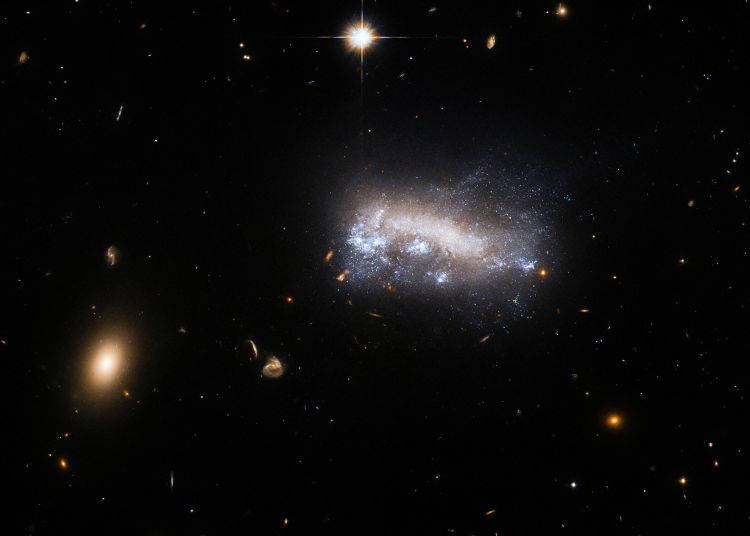A captivating image captured by the Hubble Space Telescope reveals LEDA 42160, a dwarf galaxy locked in a cosmic tug-of-war. Located roughly 52 million light-years away within the Virgo galaxy cluster, LEDA 42160 is battling the immense pressure exerted by the surrounding gas. This phenomenon, known as ram pressure, has a dramatic impact on the galaxy’s ability to form stars.
The Stranglehold of Ram Pressure
As LEDA 42160 plows through the dense gas and dust that permeate the Virgo cluster, it encounters immense resistance. This ram pressure can act like a cosmic stranglehold, stripping the galaxy of the raw materials necessary for star formation – gas and dust. Imagine a snowball hurtling through a thick cloud of snow; the faster the snowball moves, the more resistance it encounters. In the case of LEDA 42160, the interstellar medium acts like that dense cloud, and the galaxy is the snowball. This ram pressure can be so intense that it can completely halt the creation of new stars, essentially shutting down the galaxy’s stellar nursery.
However, ram pressure can also have a counterintuitive effect. The immense pressure exerted by the surrounding gas can compress the gas and dust within the galaxy itself. Imagine squeezing a ball of dough; the internal pressure increases as you compress it. In the case of LEDA 42160, this compression can trigger a burst of star formation. The dens gas clouds become more prone to collapse, leading to the birth of new stars. The bright patches observed on the lower-right side of LEDA 42160 might be a testament to this phenomenon, acting as stellar nurseries brimming with newborn stars.
Unveiling the Secrets of Star Formation
This Hubble observation is part of a larger project investigating the impact of ram pressure on dwarf galaxies residing in massive clusters like Virgo. While previous studies suggest ram pressure can trigger star formation in larger galaxies, scientists are now investigating its effect on smaller galaxies like LEDA 42160. Understanding how these forces play out in different galactic environments is crucial for creating a comprehensive picture of star formation across the cosmos.

By studying LEDA 42160 in detail, astronomers hope to gain a deeper understanding of the complex interplay between ram pressure and star formation. This knowledge will shed light on the processes that govern the birth of stars in galaxies throughout the universe. Imagine a cosmic recipe for star formation; ram pressure adds another crucial ingredient to this recipe, influencing the rate and location of star birth within galaxies.
Hubble’s observations of LEDA 42160 offer a glimpse into the dynamic forces shaping galaxies within dense clusters. The findings will not only improve our understanding of star formation in these extreme environments but also provide valuable insights into the evolution of galaxies within the vast cosmic web. Galaxies like LEDA 42160, locked in a cosmic tug-of-war with the surrounding gas, offer a unique window into the delicate balance between star formation and galactic evolution.



















